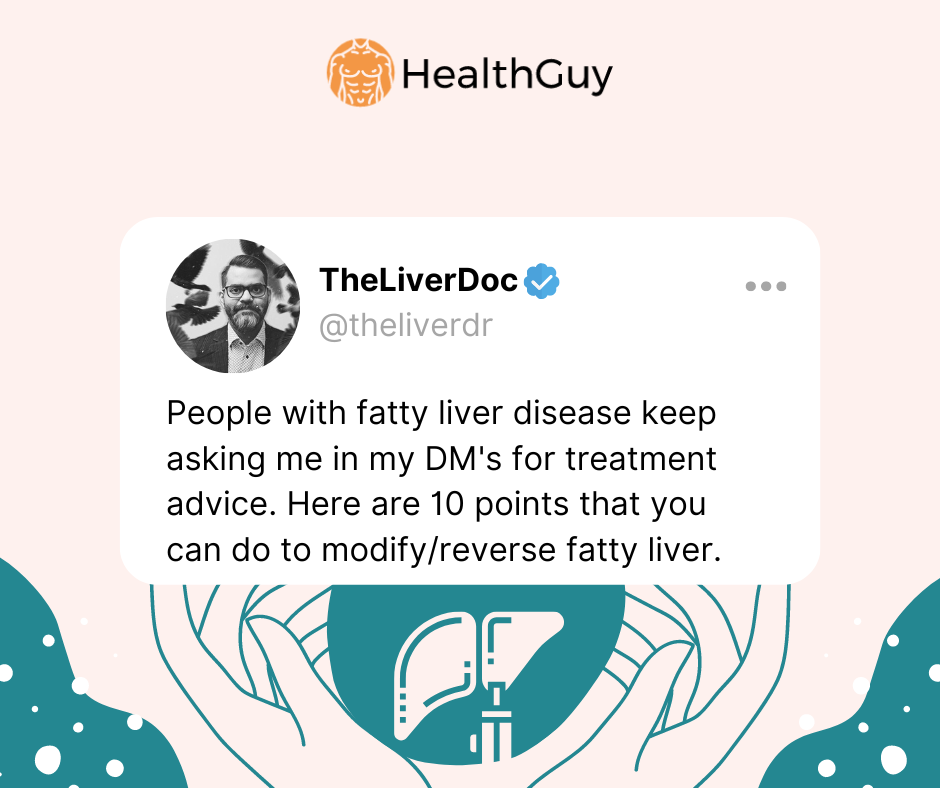
Fatty Liver Disease: 10 Ways to Modify/Reverse It – Insights from @theliverdr
Fatty liver disease is a condition where excess fat accumulates in the liver, leading to liver damage and inflammation. It is a common condition that affects about 25% of the adult population worldwide. It is typically associated with obesity, diabetes, and other metabolic disorders. However, fatty liver disease can also occur in people who are not overweight or have no known metabolic problems.
According to a recent Twitter thread by @theliverdr (2022, March 16) https://twitter.com/theliverdr/status/1636274992794173440?s=46&t=tpHakyWBZDL1O92K6Oyw0w a leading hepatologist with over 10 years of experience in treating liver diseases, there are several ways to modify or reverse fatty liver disease.
- Exercise: Exercise is one of the most effective ways to improve fatty liver disease. Studies have shown that different types of exercise, such as aerobic exercise, resistance training, and high-intensity interval training, can reduce liver fat and improve liver function. Therefore, it is recommended to include any of these exercises in your routine. The optimal duration and intensity of exercise required to improve fatty liver disease may vary depending on individual factors. However, as a general rule, aim for at least 150 minutes of moderate-intensity exercise or 75 minutes of high-intensity exercise per week.
- Diet: Diet plays a crucial role in the development and progression of fatty liver disease. However, it is not the carbohydrates or the fat in your diet that causes the problem; it is the excess calories. Therefore, low-calorie dietary interventions are most effective in reducing liver fat. A low-calorie diet is typically defined as a daily calorie intake of 1000 to 1500 calories with a deficit of 500 to 750 calories per day. Apart from low-calorie deficits, the only other dietary intervention with proven use is the Mediterranean diet without alcohol.
- Sleep: Poor sleep quality and quantity can increase the risk of developing fatty liver disease. Several studies have shown that inadequate sleep, non-restorative sleep, and daytime napping for more than 60 minutes are independently associated with the new onset or worsening of fatty liver disease. Therefore, it is essential to ensure that you get enough high-quality sleep every night.
- Coffee: Coffee intake has been shown to reduce the risk of fatty liver disease independent of other dietary modifications. Studies have found that drinking at least three cups of black coffee without sugar or milk a day can reduce liver fat. However, consuming coffee before the late evening is important and not at night. Also, avoid drinking coffee if you have high blood pressure, as it may increase your blood pressure.
- Alcohol: Alcohol use is the most common cause of fatty liver disease. The safest level of alcohol consumption in preventing fatty liver is ZERO. Therefore, if you have fatty liver disease, it is crucial to stop drinking alcohol and switch to non-alcoholic, low-calorie beverages instead.
- Sugar-sweetened beverages and fructose-containing processed foods: Sugar-sweetened beverages and fructose-containing processed foods should be avoided if you have fatty liver disease. These can increase liver fat immensely and have been linked to fatty liver disease in both children and adults. Therefore, limiting your intake of these foods and drinks is important.
- Artificial sweeteners: Artificial sweeteners are safer to use than natural sugars, but some preclinical studies have shown increased liver fat in animal models due to their action on gut bacteria. Therefore, it is important to choose artificial sweeteners carefully. Stevia is considered the safest bet among artificial sweeteners. However, if you have diabetes or obesity, it is best to speak with your specialist before using artificial sweeteners.
- Drug therapy: Currently, there are no approved drugs for the treatment of fatty liver disease. However, vitamin E and Pioglitazone have been recommended for use. Other drugs are not useful. Drug therapy should only be initiated in people with confirmed NASH (ideally biopsy-proven or Fibroscan/Shearwave) and not based on an ultrasound scan.
- Rational approach: Fatty liver disease is a misnomer as it’s not really a disease, but an association. Treatment should focus on controlling the causes of fatty liver disease, such as alcohol use, diabetes, obesity, hypothyroidism, sleep disorder, and sedentary lifestyles.
- What doesn’t work: Ursodeoxycholic acid, milk thistle, green tea, omega-3 supplements, detox products, yoga (because it’s not aerobic), fruitarian diets, crash diets, turmeric/cinnamon supplements, shifting to honey or coconut sugars, herbal formulations, multiherbal products, any product with “liver detox” written on it, and any product or advertisement with “reverse fatty liver” written on it.
In conclusion, fatty liver disease can be modified or reversed through various lifestyle modifications. These include regular exercise, a low-calorie diet, quality sleep, limiting alcohol intake, avoiding sugar-sweetened beverages and fructose-containing processed foods, and being cautious about the use of artificial sweeteners. However, it is important to note that there are currently no approved drugs for the treatment of fatty liver disease. Treatment should instead focus on controlling underlying causes, such as alcohol use, diabetes, obesity, and hypothyroidism. Additionally, there is no evidence that any specific supplements or detox products can effectively reverse fatty liver disease. By making these lifestyle changes and seeking appropriate medical care, those with fatty liver disease can improve their liver health and overall well-being.
